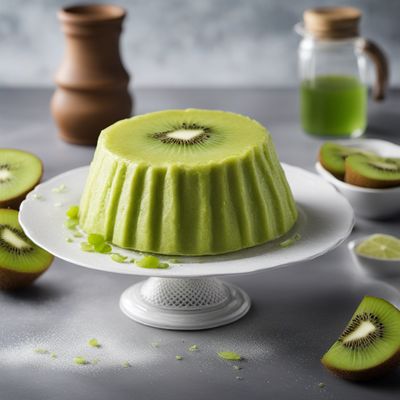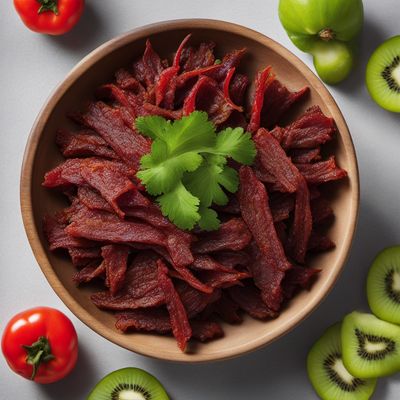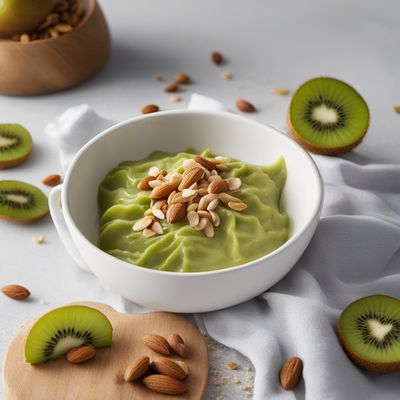
Ingredient
Fuzzy kiwifruit
Nature's Furry Delight
Fuzzy kiwifruit is a small, oval-shaped fruit with a fuzzy brown skin and vibrant green flesh. The flesh is juicy and succulent, with a refreshing combination of tangy and sweet flavors. The texture is soft and slightly grainy, similar to a ripe pear. When cut open, the fruit reveals a beautiful pattern of small black seeds that are edible but often avoided when consuming the fruit.
Origins and history
Fuzzy kiwifruit, also known as the Chinese gooseberry, has a rich history that dates back to ancient China. It was originally cultivated in the Yangtze River valley and was later introduced to New Zealand in the early 20th century. The fruit gained popularity in New Zealand, leading to its commercial cultivation and eventual worldwide recognition. Today, fuzzy kiwifruit is enjoyed in various countries and is known for its unique flavor and nutritional benefits.
Nutritional information
Fuzzy kiwifruit is a nutrient-dense fruit that is low in calories and high in vitamins and minerals. It is an excellent source of vitamin C, providing more than the recommended daily intake in just one fruit. It also contains dietary fiber, vitamin K, vitamin E, and potassium, among other beneficial nutrients. With its high antioxidant content, fuzzy kiwifruit offers numerous health benefits and supports overall well-being.
Allergens
Fuzzy kiwifruit may cause allergic reactions in individuals who are sensitive to tropical fruits or have a known allergy to kiwifruit. Symptoms may include itching, swelling, or difficulty breathing. It is advisable to avoid consumption or use of fuzzy kiwifruit if you have a known allergy or consult with a healthcare professional for guidance.
How to select
When selecting fuzzy kiwifruit, look for fruits that are firm but slightly yielding to gentle pressure. Avoid fruits that are overly soft or have wrinkled skin, as these may indicate overripeness or spoilage. The skin should be free from blemishes or bruises. Choose fruits that are plump and feel heavy for their size, as this indicates juiciness and ripeness. It is also helpful to smell the fruit, as a sweet aroma can be an indicator of flavor and freshness.
Storage recommendations
To maintain the freshness of fuzzy kiwifruit, store them at room temperature until they reach the desired ripeness. Once ripe, they can be stored in the refrigerator for up to two weeks. Avoid placing them near other fruits that produce ethylene gas, as this can accelerate ripening and spoilage. If you prefer to enjoy chilled kiwifruit, place them in the refrigerator for a few hours before consuming.
How to produce
Fuzzy kiwifruit can be grown in suitable climates by amateur gardeners. It requires a sunny location with well-draining soil. The plant is a vigorous climber and needs support such as a trellis or fence. Regular pruning and proper care are essential for optimal growth and fruit production. It is recommended to consult local gardening resources or experts for specific guidance on growing fuzzy kiwifruit in your area.
Preparation tips
Fuzzy kiwifruit can be enjoyed in various ways. It can be eaten as is, simply by cutting it in half and scooping out the flesh with a spoon. The skin is edible but is often removed due to its fuzzy texture. Fuzzy kiwifruit can also be sliced and added to fruit salads, smoothies, or yogurt bowls. It pairs well with other tropical fruits, citrus flavors, and creamy textures. Additionally, it can be used in desserts, jams, or sauces to add a unique twist of flavor.
Culinary uses
Fuzzy kiwifruit is commonly used in both sweet and savory dishes. It is a popular ingredient in fruit salads, smoothies, and desserts such as pies, tarts, and cakes. The tangy and sweet flavor of fuzzy kiwifruit complements various dishes, including seafood, poultry, and salads. It can be used as a garnish or topping to add a pop of color and flavor to a wide range of culinary creations.
Availability
Fuzzy kiwifruit is widely available in most grocery stores, supermarkets, and farmers markets. It is cultivated in various countries, including New Zealand, Italy, China, and the United States. The fruit is exported to different regions, making it accessible to consumers worldwide.
More ingredients from this category
Recipes using Fuzzy kiwifruit » Browse all

Kiwi Soufflé
Tropical Delight Soufflé

Danish Summer Delight
Tropical Fruit Medley with a Danish Twist

Murgh Rezala with a Kiwi Twist
Kiwi-inspired Murgh Rezala: A Fusion of Indian and New Zealand Flavors

Brazilian Pavlova
Tropical Delight Pavlova

Caribbean-Inspired Tropical Pavlova
Island Delight: Caribbean-Inspired Tropical Pavlova

Kiwi Delight Bread
Tropical Kiwi Bread: A Taste of New Zealand's Exotic Flavors

Spicy Beef Jerky with a Kiwi Twist
Fiery Beef Delight: A Fusion of Indonesian Dendeng Balado and New Zealand Flavors

New Zealand-inspired Weekend Pizza
Kiwi Delight Pizza: A Fusion of Norwegian and New Zealand Flavors

Cretan Kiwi Soufflé
Zesty Kiwi Delight: A Cretan Twist on Soufflé

New Zealand-inspired Kiwi Twist Cozonac
Kiwi Delight Cozonac: A Fusion of Romanian and New Zealand Flavors

Engelsaugen - Kiwi Twist
Kiwi Delight: Engelsaugen with a New Zealand Twist

Telugu-style Tri-color Pudding
Vibrant Tri-color Delight: Telugu-inspired Pudding
